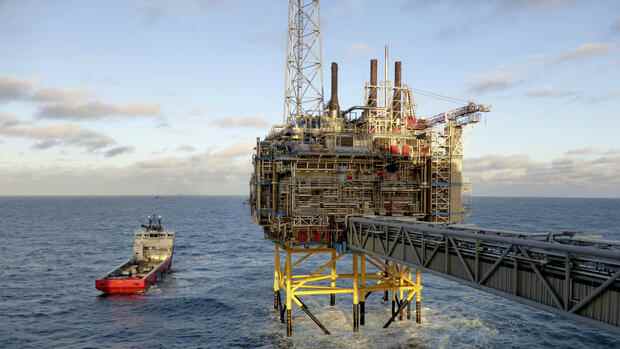Stockholm First Russia throttled its gas supplies, now Europe’s energy supply is in even greater jeopardy. The strike by 74 workers on three Norwegian oil and gas platforms could exacerbate the already tense situation in the European gas market. The walkout could result in a loss of up to a quarter of Norway’s gas production.
So far, 89,000 barrels of oil equivalent have been lost due to the industrial action, said a spokesman for the Norwegian industrial association Norsk olje og gass. Gas production accounted for 27,500 barrels of oil equivalent. Prices rose on the commodity markets because of the strike: the British wholesale price for gas for next-day delivery jumped a good 18 percent.
Because of the work stoppages, the Norwegian energy company Equinor stopped oil and gas production in the Gudrun, Oseberg Sör and Oseberg Öst fields. As early as Wednesday, another 117 workers in the Heidrun, Aasta Hansteen and Kristin fields want to lay down their work.
A seventh field, Tyrihans, must also be closed as the strike expands as it processes production from the Kristin field. According to Norsk olje og gass, around 13 percent of Norway’s total gas production could then be eliminated. The Scandinavian country loses around 50 million euros a day as a result of the work stoppages.
Top jobs of the day
Find the best jobs now and
be notified by email.
After the throttling of Russian gas supplies, the EU countries are more dependent than ever on supplies from Norway. Even before the war in Ukraine, Norway was one of the most important suppliers of oil and gas. About a fifth of the gas supplies to the countries of the EU come from Norway, about 40 percent came from Russia before the outbreak of the war.
Last month, representatives of the EU and Norway successfully negotiated an increase in delivery volumes. The Scandinavian country has agreed to increase gas production by around eight percent this year.
Government can force end of strike
The Norwegian Ministry of Labor wants to follow the strike “closely”, as a spokesman emphasized. In Norway, which derives around half of its total export earnings from oil and gas exploration, the government can legislate to end a strike in “extraordinary circumstances”.
>>Read here: Russia’s revenge: Europe is not prepared for a possible gas supply stop
The strike broke out after a failed mediation attempt last week. The Lederne oil and gas workers’ union is demanding a wage increase of 5.7 percent because of the significant increase in inflation in Norway.
Despite the deadlocked negotiations, union boss Audun Ingvartsen signaled further willingness to talk. “An agreement should not fail because of us,” he said on Norwegian radio station NRK.
However, if no agreement is reached between the collective bargaining partners in the coming days, the strike can be significantly extended from July 9th. The union speaks of a total of 382 oil and gas workers who will then walk down.
Norway was recently accused of profiting from the Russian invasion of Ukraine and the resulting sharp rise in oil and gas prices. However, the government in Oslo has contradicted this. “We have higher income from oil and gas sales, but the oil fund has lost more than income has increased,” said Norway’s Finance Minister Trygve Slagsvold.
>>Read here: These ten sectors would be most affected by a gas supply stop
The Norwegian Oil Fund is the largest sovereign wealth fund in the world. It was founded in 1996 in order to be able to finance the welfare state even after the oil and gas wells have dried up. State revenues from the country’s oil business flow into the fund. However, it not only serves to provide social security, but is also intended to keep the national budget in balance.
The sovereign wealth fund is currently involved in around 9,000 companies in 80 countries. He owns around 1.4 percent of the shares issued worldwide and 2.5 percent of the European shares. In Germany, the fund holds shares in more than four percent of the Dax companies.
Since Russian troops invaded Ukraine, the fund has drastically reduced its investments in Russia: Before the war broke out it was 27 billion crowns (2.6 billion euros) and now it is only around 2.4 billion. Since the war, the fund’s assets under management have actually declined. At the end of last year, the fund managed 12.34 trillion crowns, today it is still 11.74 trillion crowns.
More: Norway’s energy group Equinor: “We deliver as much gas as possible”
